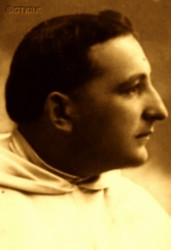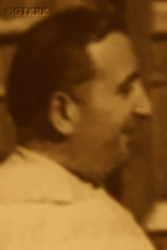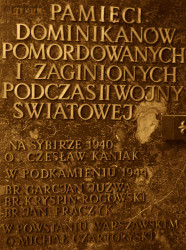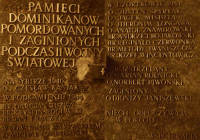Roman Catholic
St Sigismund parish
05-507 Słomczyn
85 Wiślana Str.
Konstancin deanery
Warsaw archdiocese, Poland
full list:
displayClick to display full list

searchClick to search full list by categories
wyświetlKliknij by wyświetlić pełną listę po polsku

szukajKliknij by przeszukać listę wg kategorii po polsku

Martyrology of the clergy — Poland
XX century (1914 – 1989)
personal data
surname
KANIAK
forename(s)
Michael Augustus (pl. Michał August)
religious forename(s)
Ceslav (pl. Czesław)
function
religious cleric
creed
Latin (Roman Catholic) Church RCmore on
en.wikipedia.org
[access: 2014.09.21]
congregation
Order of Preachers OPmore on
en.wikipedia.org
[access: 2013.07.06]
(i.e. Dominican Order, Dominicans)
diocese / province
St Hyacinth Polish Province
St Hyacinth Galicia Province OP
Lviv archdiocesemore on
en.wikipedia.org
[access: 2013.05.19]
RC Military Ordinariate of Polandmore on
en.wikipedia.org
[access: 2014.12.20]
academic distinctions
Dominican Fathers' Lector of Holy Theology
date and place
of death
24.03.1941

Kropyvnytskyitoday: Kropyvnytsky city rai., Kirovohrad obl., Ukraine
more on
en.wikipedia.org
[access: 2021.09.17]
alt. dates and places
of death
1940, 1941
Lvivtoday: Lviv urban hrom., Lviv rai., Lviv obl., Ukraine
more on
en.wikipedia.org
[access: 2022.01.16]
details of death
After German and Russian invasion of Poland in 09.1939 and start of the World War II, after start of Russian occupation, became de facto prior of Lviv monastery.
Got involved in efforts to help Poles deported by the Russians to Siberia and their orphaned families.
Allowed the Lviv Theological Seminary to conduct activities in his monastery.
In the evening permitted professors of the John Casimir University to clandestinely lecture and conduct exercises for their students.
Collaborated with an emerging Polish clandestine resistance Armed Struggle Union ZWZ organization (part of later Polish Clandestine State) — e.g. in hid the so‐called „Poznań pawnshop treasure” (deposits of Poznań „Mons Pius” bank brought to Lviv in 1939, and used to cover cost of clandestine travel of Polish soldiers to France to join the army being organized by Polish Prime Minister, Gen. Sikorski) in his monastery.
As a member of ZWZ finance committee collaborated with Fr Adam Bogdanowicz and Fr Joseph Panaś.
Arrested on 13.04.1940 by Russian NKVD during mass arrests of Lviv members of ZWZ.
Part of them were subsequently sentenced to death in the so‐called „Trial of the Fourteen”.
Held in Lviv prison and next transported away in an „unknown direction”.
Prob. on 29.11(09).1940 in Kirovohrad „sentenced” by the Russians to death and there murdered in prison.
cause of death
mass murder
perpetrators
Russians
sites and events
Trial of 19‐20.11.1940Click to display the description, Lviv (Zamarstiniv)Click to display the description, Deportations to SiberiaClick to display the description, Ribbentrop‐MolotovClick to display the description, Pius XI's encyclicalsClick to display the description
date and place
of birth
12.09.1892Birth certification on:
agadd.home.net.pl
[access: 2025.08.19]

Lvivtoday: Lviv urban hrom., Lviv rai., Lviv obl., Ukraine
more on
en.wikipedia.org
[access: 2022.01.16]
parents
KANIAK Augustus
🞲 ?, ? — 🕆 ?, ?

RIEDL Thecla
🞲 ?, ? — 🕆 ?, ?
baptism
25.09.1892Birth certification on:
agadd.home.net.pl
[access: 2025.08.19]

Lvivtoday: Lviv urban hrom., Lviv rai., Lviv obl., Ukraine
more on
en.wikipedia.org
[access: 2022.01.16]
St Nicholas the Bishop and Confessor RC church
religious vows
1910 (temporary)
presbyter (holy orders)
ordination
12.09.1915

Szombathelytoday: Vas cou., Hungary
more on
en.wikipedia.org
[access: 2024.03.19]
positions held
till 1940
deputy prior — Lvivtoday: Lviv urban hrom., Lviv rai., Lviv obl., Ukraine
more on
en.wikipedia.org
[access: 2022.01.16] ⋄ Corpus Christi monastery, Dominicans OP — from 1939 de facto prior; also: monastery censor of books, confessor of women's congregations in Lviv
1934 – 1937
professor — Lvivtoday: Lviv urban hrom., Lviv rai., Lviv obl., Ukraine
more on
en.wikipedia.org
[access: 2022.01.16] ⋄ Philosophical and Theological Studies, Corpus Christi monastery, Dominicans OP — lecturer in exegesis and introduction to the Holy Scriptures; also: head of the branch of the Third Secular Order of St Dominic
1930 – 1933
prior — Ternopiltoday: Ternopil urban hrom., Ternopil rai., Ternopil obl., Ukraine
more on
en.wikipedia.org
[access: 2020.11.20] ⋄ St Vincent Ferrer monastery, Dominicans OP
1918 – 1930
professor — Lvivtoday: Lviv urban hrom., Lviv rai., Lviv obl., Ukraine
more on
en.wikipedia.org
[access: 2022.01.16] ⋄ Philosophical and Theological Studies, Corpus Christi monastery, Dominicans OP — lecturer in exegesis and introduction to the Holy Scriptures, Hebrew (from 1923), Church history; also: infirmary assistant (from 1919), head of the St Thomas Aquinas Association, monastery censor of books, member of the monastery council, head of the branch of the Third Secular Order of St Dominic
1915 – 1918
student — Viennatoday: Vienna state, Austria
more on
en.wikipedia.org
[access: 2020.07.31] ⋄ theology, Alma Mater Rudolphina Vindobonensis (Eng. University of Vienna), i.e. Rudolphina — postgraduate specialised studies in the field of scripturistics and the Hebrew language, crowned with the Order's diploma Lector of Sacred Theology (1917)
1912 – 1915
student — Rometoday: Rome prov., Lazio reg., Italy
more on
en.wikipedia.org
[access: 2021.12.18] ⋄ philosophy and theology, „Angelicum” [i.e. Lat. Pontificia Universitas Studiorum a Sancto Thoma Aquinate in Urbe (Eng. Pontifical University of St Thomas Aquinas) (today) / Lat. Pontificium Institutum Internationale (Eng. Pontifical International Institute) (1926‐1963) / Lat. Pontificium Collegium (Eng. Pontifical College) (1906‐1926) / Lat. Collegium (Eng. College) (until 1906)]
1910 – 1912
student — Lvivtoday: Lviv urban hrom., Lviv rai., Lviv obl., Ukraine
more on
en.wikipedia.org
[access: 2022.01.16] ⋄ Philosophical and Theological Studies, Corpus Christi monastery, Dominicans OP — also: student of the last years of gymnasium
1909 – 1910
novitiate — Krakówtoday: Kraków city pov., Lesser Poland voiv., Poland
more on
en.wikipedia.org
[access: 2021.06.07] ⋄ Holy Trinity monastery, Dominicans OP
09.08.1909
accession — Krakówtoday: Kraków city pov., Lesser Poland voiv., Poland
more on
en.wikipedia.org
[access: 2021.06.07] ⋄ Holy Trinity monastery, Dominicans OP
author of the „Handbook of the Third Order of St Dominic”, Lviv 1932, 1931, 1934, containing the Polish translation of the Rule of the Third Secular Order of St Dominic
others related
in death
BOGDANOWICZ–ROSZKOClick to display biography Adam Henry, KISIELClick to display biography John, PANAŚClick to display biography Joseph
sites and events
descriptions
Trial of 19‐20.11.1940: In 03.1940 till 06.1940 Russians arrested in Lviv hundreds of members of an emerging Polish clandestine resistance Armed Struggle Union ZWZ organization (part of later Polish Clandestine State). They were held in Lviv prisons. Tortured (special fame earned Russian genocidal NKVD sadistic member, J. M. Libenson of Jewish origin). 14 of them were tried in Zamarstynów prison during the night of 19‐20.11.1940, before a «NKVD Troika» — a murderous Russian court. Prosecuted Mr Nowicki, Ukrainian. All stated that they were proud members of ZWZ. At 02:00 in the morning 13 of them were sentenced to death, among them two priests. One, as a juvenile, got 10 years in Russian concentration camps Gulag (and perished there, prob. in Kołyma). On 11.12.1940 Russian Kiev prosecutors’ office „did not endorse cassation applications” (one of the condemned, Fr Bogdanowicz, wrote his in Polish!). On 21.12.1940 the Criminal College at Supreme Court in Kiev upheld most of the sentences. Finally on 17.02.1941 all sentences were upheld by Russian Supreme Court in Moscow. All condemned in this „trial of the fourteen” were thus executed by the Russians, prob. Katyń style, with a shot to the back of the head. (more on: www.google.plClick to attempt to display webpage
[access: 2017.01.21])
Lviv (Zamarstiniv): Penal prison no 2 in Lviv. In 1939‐1941 Russians organised there an NKVD detention centre and jailed thousands of prisoners, mainly Poles and Ukrainians, interrogating them and torturing. In 06.1941 after German invasion Russians murdered few thousands of them in a mass massacre. (more on: pl.wikipedia.orgClick to attempt to display webpage
[access: 2015.09.30])
Deportations to Siberia: In 1939‐1941 Russians deported — in four large groups in: 10.02.1940, 13‐14.04.1940, 05‐07.1940, 05‐06.1941 — up to 1 mln of Polish citizens from Russian occupied Poland to Siberia leaving them without any support at the place of exile. Thousands of them perished or never returned. The deportations east, deep into Russia, to Siberia resumed after 1944 when Russians took over Poland. (more on: en.wikipedia.orgClick to attempt to display webpage
[access: 2014.09.21])
Ribbentrop‐Molotov: Genocidal Russian‐German alliance pact between Russian leader Joseph Stalin and German leader Adolf Hitler signed on 23.08.1939 in Moscow by respective foreign ministers, Mr. Vyacheslav Molotov for Russia and Joachim von Ribbentrop for Germany. The pact sanctioned and was the direct cause of joint Russian and German invasion of Poland and the outbreak of the World War II in 09.1939. In a political sense, the pact was an attempt to restore the status quo ante before 1914, with one exception, namely the „commercial” exchange of the so‐called „Kingdom of Poland”, which in 1914 was part of the Russian Empire, fore Eastern Galicia (today's western Ukraine), in 1914 belonging to the Austro‐Hungarian Empire. Galicia, including Lviv, was to be taken over by the Russians, the „Kingdom of Poland” — under the name of the General Governorate — Germany. The resultant „war was one of the greatest calamities and dramas of humanity in history, for two atheistic and anti‐Christian ideologies — national and international socialism — rejected God and His fifth Decalogue commandment: Thou shall not kill!” (Abp Stanislav Gądecki, 01.09.2019). The decisions taken — backed up by the betrayal of the formal allies of Poland, France and Germany, which on 12.09.1939, at a joint conference in Abbeville, decided not to provide aid to attacked Poland and not to take military action against Germany (a clear breach of treaty obligations with Poland) — were on 28.09.1939 slightly altered and made more precise when a treaty on „German‐Russian boundaries and friendship” was agreed by the same murderous signatories. One of its findings was establishment of spheres of influence in Central and Eastern Europe and in consequence IV partition of Poland. In one of its secret annexes agreed, that: „the Signatories will not tolerate on its respective territories any Polish propaganda that affects the territory of the other Side. On their respective territories they will suppress all such propaganda and inform each other of the measures taken to accomplish it”. The agreements resulted in a series of meeting between two genocidal organization representing both sides — German Gestapo and Russian NKVD when coordination of efforts to exterminate Polish intelligentsia and Polish leading classes (in Germany called «Intelligenzaktion», in Russia took the form of Katyń massacres) where discussed. Resulted in deaths of hundreds of thousands of Polish intelligentsia, including thousands of priests presented here, and tens of millions of ordinary people,. The results of this Russian‐German pact lasted till 1989 and are still in evidence even today. (more on: en.wikipedia.orgClick to attempt to display webpage
[access: 2015.09.30])
Pius XI's encyclicals: Facing the creation of two totalitarian systems in Europe, which seemed to compete with each other, though there were more similarities than contradictions between them, Pope Pius XI issued in 03.1937 (within 5 days) two encyclicals. In the „Mit brennender Sorge” (Eng. „With Burning Concern”) published on 14.03.1938, condemned the national socialism prevailing in Germany. The Pope wrote: „Whoever, following the old Germanic‐pre‐Christian beliefs, puts various impersonal fate in the place of a personal God, denies the wisdom of God and Providence […], whoever exalts earthly values: race or nation, or state, or state system, representatives of state power or other fundamental values of human society, […] and makes them the highest standard of all values, including religious ones, and idolizes them, this one […] is far from true faith in God and from a worldview corresponding to such faith”. On 19.03.1937, published „Divini Redemptoris” (Eng. „Divine Redeemer”), in which criticized Russian communism, dialectical materialism and the class struggle theory. The Pope wrote: „Communism deprives man of freedom, and therefore the spiritual basis of all life norms. It deprives the human person of all his dignity and any moral support with which he could resist the onslaught of blind passions […] This is the new gospel that Bolshevik and godless communism preaches as a message of salvation and redemption of humanity”… Pius XI demanded that the established human law be subjected to the natural law of God , recommended the implementation of the ideal of a Christian state and society, and called on Catholics to resist. Two years later, National Socialist Germany and Communist Russia came together and started World War II. (more on: www.vatican.vaClick to attempt to display webpage
[access: 2023.05.28], www.vatican.vaClick to attempt to display webpage
[access: 2023.05.28])
sources
personal:
www.jerzyrobertnowak.comClick to attempt to display webpage
[access: 2012.11.23], cracovia-leopolis.plClick to attempt to display webpage
[access: 2013.01.06], agadd.home.net.plClick to attempt to display webpage
[access: 2025.08.19], otk.armenia.plClick to attempt to display webpage
[access: 2013.06.23], biographies.library.nd.eduClick to attempt to display webpage
[access: 2014.05.09]
bibliographical:
„Trial of the Fourteen”, Ms Elisabeth Kotarska, Volumen, 1998
„Register of Latin rite Lviv metropolis clergy’s losses in 1939‐45”, Józef Krętosz, Maria Pawłowiczowa, editors, Opole, 2005
„Biographical lexicon of Lviv Roman Catholic Metropoly clergy victims of the II World War 1939‐1945”, Mary Pawłowiczowa (ed.), Fr Joseph Krętosz (ed.), Holy Cross Publishing, Opole, 2007
„Lexicon of Polish clergy repressed in USSR in 1939‐1988”, Roman Dzwonkowski, SAC, ed. Science Society KUL, 2003, Lublin
original images:
www.sowiniec.com.plClick to attempt to display webpage
[access: 2014.11.22], ipn.gov.plClick to attempt to display webpage
[access: 2019.02.02]
LETTER to CUSTODIAN/ADMINISTRATOR
If you have an Email client on your communicator/computer — such as Mozilla Thunderbird, Windows Mail or Microsoft Outlook, described at WikipediaPatrz:
en.wikipedia.org, among others — try the link below, please:
LETTER to CUSTODIAN/ADMINISTRATORClick and try to call your own Email client
If however you do not run such a client or the above link is not active please send an email to the Custodian/Administrator using your account — in your customary email/correspondence engine — at the following address:

giving the following as the subject:
MARTYROLOGY: KANIAK Michael Augustus
To return to the biography press below:
 Click to return to biography
Click to return to biography












